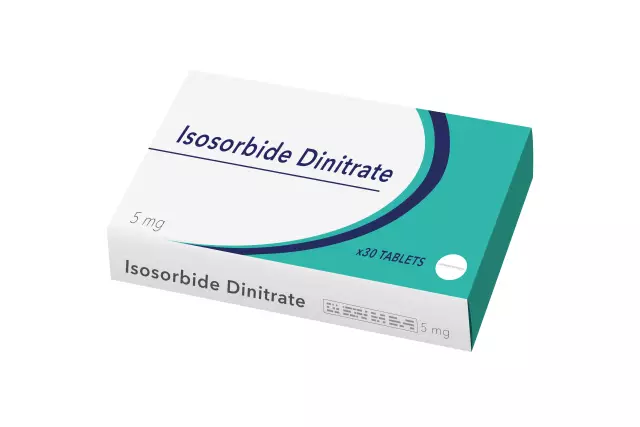- Author Rachel Wainwright [email protected].
- Public 2023-12-15 07:39.
- Last modified 2025-11-02 20:14.
Isosorbide
Instructions for use:
- 1. Pharmacological action
- 2. Release form
- 3. Indications for use
- 4. Contraindications
- 5. Instructions for use
- 6. Side effects
- 7. Storage conditions

Isosorbide is a nitrous antianginal drug used for the treatment and prevention of angina pectoris.
pharmachologic effect
Isosorbide is a highly effective drug for the treatment of coronary heart disease and relieving angina attacks.
It has a vasodilating, antianginal and coronary dilating effect, reduces the tone of the vascular walls and causes vasodilation.
There are two types of this nitro-containing drug, the action of which is identical, but has a number of differences:
Isosorbide dinitrate is a traditional antianginal drug. Reduces pressure and venous blood flow to the heart, choking, shortness of breath and blue skin and mucous membranes due to oxygen deficiency. With regular use, its antianginal and anti-ischemic effect decreases.
Isosorbide mononitrate is absorbed into the blood faster and is not metabolized in the liver, which makes it more effective than Isosorbide dinitrate.
Release form
Isosorbide mononitrate is produced as:
- Tablets of 20 mg (50 pieces per package) and 40 mg (20 pieces per package);
- 1% solution in ampoules of 1 ml (50 pieces per package).
Isosorbide dinitrate is produced as:
- Tablets of 5 mg, 10 mg and 20 mg (20 and 50 pieces per package);
- Solution for infusion in 10 ml ampoules and 50 ml vials.
On the basis of these nitrate compounds, special drugs are produced in the form of a sublingual metered aerosol and spray, capsules and prolonged-release tablets and films for gluing on the gums.
Indications for the use of Isosorbide
Isosorbide is used for relief and prevention of angina attacks, rehabilitation treatment after myocardial infarction, as well as for:
- Inflammation of the inner lining of the arteries;
- Some forms of pulmonary hypertension;
- Chronic heart failure;
- Cor pulmonale, as part of combination therapy.
As an ambulance for the relief and prevention of an attack of angina pectoris, myocardial infarction Isosorbide dinitrate is used by inhalation.
The drug is used intravenously for:
- Unstable angina;
- Pulmonary edema;
- Acute myocardial infarction.
Often, Isosorbide dinitrate is used like nitroglycerin to expand the lumen of blood vessels in acute heart failure.
Isosorbide mononitrate is used in combination therapy in the treatment of chronic heart failure.
Contraindications
Isosorbide is contraindicated in:
- Hypersensitivity to organic nitrates;
- Increased intracranial pressure and low blood pressure;
- Brain hemorrhage and traumatic brain injury;
- Angle-closure glaucoma (with open-angle glaucoma, Isosorbide can be used).
Isosorbide dinitrate is not used intravenously for hemorrhagic stroke, cardiac tamponade and constrictive pericarditis.
With caution, Isosorbide is prescribed for liver failure, pregnancy and lactation. In childhood, the drug is not used due to the lack of clinical studies.
Instructions for the use of Isosorbide

Isosorbide dinitrate tablets are taken orally before meals. The standard dose is 5-10 mg of the drug 3-4 times a day. Tablets taken sublingually (under the tongue, the tablet can be chewed to speed up the action), relieve angina attacks. With regular intake for more than 3-6 weeks, it is recommended to take a break, replacing the drug for this time with other drugs similar in effect.
Isosorbide mononitrate as part of complex therapy for ischemic heart disease and heart failure is used 20-40 mg several times a day.
Intravenous drip or slow injection of 1-5 ampoules per day.
Side effects
When using Isosorbide, nausea, headache and dizziness may occur. Often these symptoms disappear with a decrease in the dose of the drug.
Do not drink alcohol while using Isosorbide.
Storage conditions
Isosorbide is classified as a List B. Shelf life - 3 years.
Information about the drug is generalized, provided for informational purposes only and does not replace the official instructions. Self-medication is hazardous to health!






